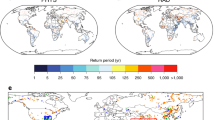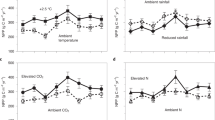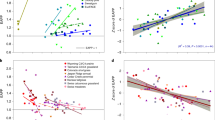Abstract
Increasing atmospheric carbon dioxide concentrations are expected1 to cause major changes in the world's climate over the next 50–100 yr. The impact of such changes on water resources, through changing precipitation and evaporation, will, however, be complicated by the direct effects of increasing CO2 on vegetation. In controlled environment experiments, higher CO2 levels cause the stomata of plants to close down, decreasing their rate of transpiration and increasing their water use efficiency2. Reduced evapotranspiration would make more water available as runoff and could tend to offset the effects of any CO2-induced reductions in precipitation or enhance the effects of precipitation increases. We consider here, in a simple but revealing analysis, the relative sensitivity of runoff to these two processes, changes in precipitation and changes in evapotranspiration. We show that, for low runoff ratios, small changes in precipitation may cause large changes in runoff. The magnitude and direction of these changes is, however, strongly dependent on the magnitude of the direct CO2 effect on plant evapotranspiration.
This is a preview of subscription content, access via your institution
Access options
Subscribe to this journal
Receive 51 print issues and online access
$199.00 per year
only $3.90 per issue
Buy this article
- Purchase on Springer Link
- Instant access to full article PDF
Prices may be subject to local taxes which are calculated during checkout
Similar content being viewed by others
References
NRC Changing Climate (National Academy, Washington DC, 1983).
Lemon, E. R. (ed.) CO2 and Plants: The Response of Plants to Rising Levels of Atmospheric Carbon Dioxide. A.A.A.S. Selected Symp. No. 84 (Westview, Boulder, Colorado, 1983).
Revelle, R. R. & Waggoner, P. E. in Changing Climate, 419–432 (National Academy, Washington DC, 1983).
Rind, D. & Lebedeff, S. Potential Climatic Impacts of Increasing Atmospheric CO2 with Emphasis on Water Availability and Hydrology in the United States (United States Enviromental Protection Agency Report, 1984).
Neme˘, J. in Variations in the Global Water Budget (eds Street-Perrott, A., Beran, M. & Ratcliffe, R.) 479–488 (Reidel, Dordrecht, 1983).
Aston, A. R. J. Hydrol. 67, 273–280 (1984).
Idso, S. B. & Brazel, A. J. Nature 312, 51–53 (1984).
Schaake, J. C. Jr & Kaczmarek, Z. in Proc. World Climate Conf. W.M.O. No. 528, 290–312 (World Meteorological Organization, Geneva, 1979).
Dickinson, R. E. in Geophys. Monogr. No. 29, Maurice Ewing Vol. 5 (eds Hansen, J. E. & Takahashi, T.) 58–72 (American Geophysical Union, Washington DC, 1984).
Manabe, S. & Stouffer, R. J. J. geophys. Res. 85, 5529–5554 (1980).
Wigley, T. M. L., Briffa, K. R. & Jones, P. D. Nature 312, 102–103 (1984).
Morison, J. I. L. & Gifford, R. M. Aust. J. Pl. Physiol. 11, 361–374 (1984).
Wright, C. E. Synthesis of River Flows from Weather Data (Tech. Note No. 26, Central Water Planning Unit, Reading, UK, 1978).
Jones, P. D. J. Climatol. 4, 171–186 (1984).
Korzun, V. I. (ed.) World Water Balance and Water Resources of the Earth (English transl., UNESCO, Paris, 1978).
Author information
Authors and Affiliations
Rights and permissions
About this article
Cite this article
Wigley, T., Jones, P. Influences of precipitation changes and direct CO2 effects on streamflow. Nature 314, 149–152 (1985). https://doi.org/10.1038/314149a0
Received:
Accepted:
Issue Date:
DOI: https://doi.org/10.1038/314149a0
This article is cited by
-
Decomposition of projected summer rainfall change over East Asia based on timeslice experiments
Climate Dynamics (2021)
-
Impacts of climate and land use changes on water and sediment yields for the black soil region, northeastern China
Environment, Development and Sustainability (2021)
-
Trend analysis of river flow and groundwater level for Shipra river basin in India
Arabian Journal of Geosciences (2020)
-
Decomposing East-Asian winter temperature and monsoonal circulation changes using timeslice experiments
Climate Dynamics (2020)
-
Evaluation of the Best Management Practices at the Watershed Scale to Attenuate Peak Streamflow Under Climate Change Scenarios
Water Resources Management (2016)
Comments
By submitting a comment you agree to abide by our Terms and Community Guidelines. If you find something abusive or that does not comply with our terms or guidelines please flag it as inappropriate.



